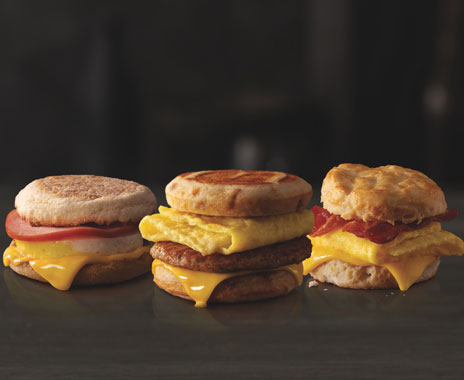Across the board, McDonald’s financial year is off to a resounding start.
The chain’s first quarter results (ended March 31) crushed analyst expectations and infused optimism into CEO Steve Easterbook’s plan to propel the fast-food leader into the future.
Easterbook, who took the helm in 2015, has pushed for menu changes, and some of those moves appear to be gaining traction, with stock market shares boosting 4 percent in early Tuesday trading to 139.66 (and climbing). Easterbook said in a webcast Tuesday that McDonald’s is “regaining lapsed customers and converting casual customers to committed customers,” by leveraging size and scale in areas designed to drive growth: digital, delivery, and the “Experience of the Future,” redesign.
The chain credited All Day Breakfast, as well as Big Mac and beverage value promotions for its comparable sales increases, which rose 1.7 percent in the U.S. at stores open for more than 13 months. Research firm Consensus Metrix estimated a 1.3 percent increase.
Global comparable sales were up 4 percent. In the International Lead segment, sales rose 2.8 percent for the quarter due to McDonald’s successful launch of All Day Breakfast in the U.K. and Canada. Kiosk usage has more than double year-over-year in Canada, McDonald’s said.
Consolidated operating income grew 14 percent and diluted earnings per share of $1.47 increased 18 percent. The company also returned $1.6 billion to shareholders through share repurchases and dividends. Net income was up 8 percent to $1.21 billion. That $1.47 per share easily beat analysts average estimate of $1.33, according to Thomson Reuters I/B/E/S.
“When value is customer focused and locally relevant, it drives guest counts. Period,” Easterbook said. “We continue to tap into our unmatched scale to ensure customers feel good about what they get and what they pay.”
Consolidated revenues decreased 4 percent—something McDonald’s credits to the impact of refranchising—to $5.68 billion. Even this decline was a positive sign, as analysts pegged estimated revenue of $5.53 billion. This marked McDonald’s 11th straight quarter of declines, but it came on optimistic terms given Easterbook’s goal to sell restaurants to franchisees. McDonald’s also closed additional stores in the first quarter to bring its count to 14,094 locations as of March 31.
Easterbrook, whose base salary increased 24 percent after his first full year to $1.3 million (he made a total of $15.4 million), is driving the brand’s turnaround after it appeared the chain was falling behind competitors from a menu and technology standpoint. Comparable sales declined 1.3 percent in the fourth quarter, although operating income was up 8 percent in 2016 and earnings per share rose 13 percent.
Many of Easterbook’s maneuvers, however, were big-picture themes that didn’t promise a quick ROI. For instance, in 2015, McDonald’s committed to sourcing cage-free eggs by 2025. Last year, it removed artificial preservatives from Chicken McNuggets, and eliminated high fructose corn syrup from the buns used on Big Macs, Quarter Pounders, hamburgers, cheeseburgers, Filet-O-Fish, and McChickens.
Then, McDonald’s promised to swap frozen for fresh beef in its Quarter Pounder burgers at the majority of restaurants by mid-2018.
McDonald’s introduced a bigger version of its Big Mac, the Grand Mac, as well as a smaller Mac Jr., in late 2015.
Also, the brand is pushing hard into mobile ordering and pay, with 14,000 locations expected to join by the end of the year, as well as an emphasis on delivery and a freshly redesigned store. Currently, more than 400 restaurants in the U.S. have mobile pay and deployment development is underway globally.
“Through delivery, we’ll bring the McDonald’s experience to more customers, whether it’s in their homes, their dorm rooms, to their workplace and beyond,” Easterbrook said. “We’re encouraged by our pilot results in Florida and are expanding to additional cities in the U.S. this quarter … we feel good about the way we’re interacting with UberEATS. They’ve proven to be a good partner for us and, hopefully, we are for them. So we’ll be expanding into a number of U.S. cities with UberEATS this quarter and demonstrating why we believe this is a velocity accelerator.”
“Whether you are at home or at the park, we are building UberEATS to serve up the right food, for right now—from salads to Big Macs—at the tap of a button. We are thrilled to partner with McDonalds to bring the ease and reliability of Uber’s technology to deliver their classic flavors,” added Jason Droege, head of UberEverything, in a statement.
Starting in May, McDonalds will start becoming available on UberEATS.
By 2020, McDonald’s hopes to have most of its U.S. free-standing restaurants updated to the “Experience of the Future,” model, which contains kiosk ordering and table service. Easterbook said the design will be in roughly 2,500 U.S. restaurants by end of 2017.


